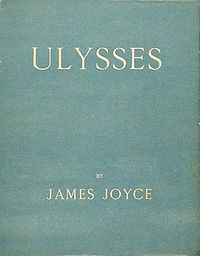
Ulysses, was first published serially in the American literary magazine, The Little Review, from March 1918 to December 1920. The magazine's editors, Margaret Anderson and Jane Heap, fought to prevent suppression of Joyce's work on grounds of obscenity and immorality. In the end, however, the censors won a court order against Anderson and Heap, restraining them from any further printing of Ulysses.
Two years later, with the aid of his friend Ezra Pound, Joyce was able to interest Sylvia Beach and her publishing firm, Shakespeare and Company, in his controversial, modernist novel. On February 2, 1922, Ulysses was published by Shakespeare and Company in Paris through the printing services of Maurice Darantiere at Dijon.
It was not until December 6, 1933, that the ban on Ulysses was lifted in the United States and published by Random House.
The New York Times reported at the end of the 20th century:
“Ulysses," that sprawling, difficult, but uniquely original masterpiece by James Joyce, has been voted the finest English-language novel published this century by a jury of scholars and writers. The book -- in which an immensely long account of a single day in the lives of a group of Dubliners becomes a metaphor for the human condition and the author experiments with language almost to the point of unintelligibility -- heads the list of 100 novels drawn up by the editorial board of Modern Library, which has been publishing classic English-language literature at affordable prices since 1917 and is now a division of Random House. http://www.nytimes.com/library/books/072098best-novels.html
The Joyce Papers 2002, c.1903-1928
http://catalogue.nli.ie/Collection/vtls000194606
When copyright on Joyce’s works in the European Union expired at the close of 2011 Joyce's writing moved into the public domain and we can now enjoy unprecedented access to manuscripts and readings. National Library of Dublin gives you access to early material; drafts etc. of Ulysses; proofs etc. for Finnegans Wake; the Joyce 2002 Papers fall into three broad categories: early material; notes and drafts for Ulysses; and proofs and additions to proofs for Finnegans Wake. In all there are over 500 manuscript pages and some 200 pages of proofs, together with some typescripts.
